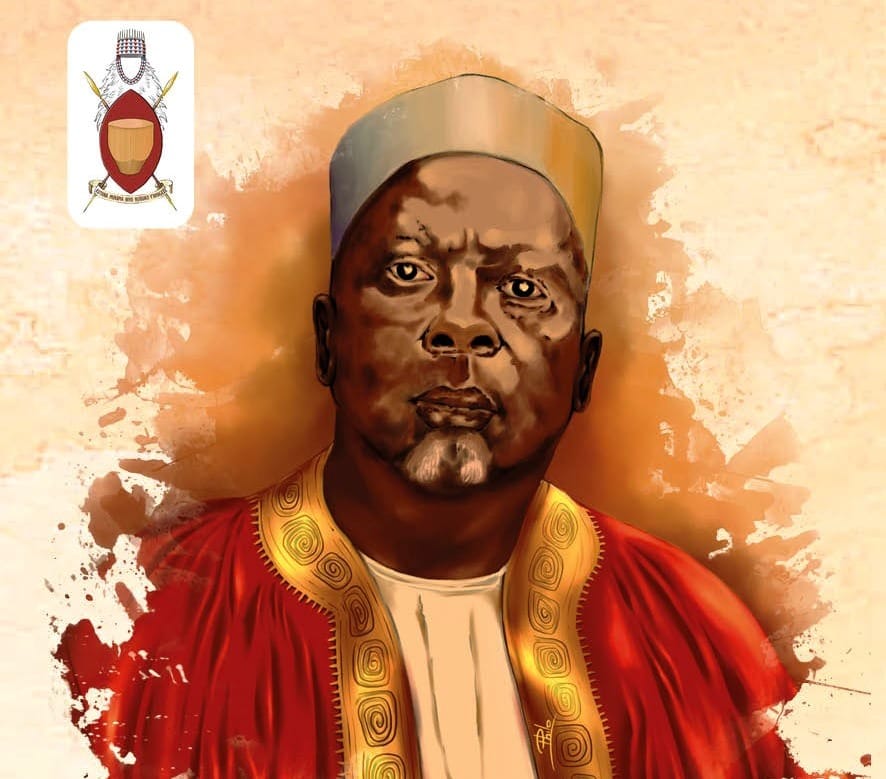The freedom of a people ultimately rests on the shoulders of the people. In Africa’s fight against colonialism, we see this fact play out as various people rose up, at one point of history or the other, to fight for the freedom of their countries. Today, we call them national heroes, giants of Africa that ensured its people found development in self-rule.
One such hero was Omukama Cwa II Kabalega who ruled the kingdom of Bunyoro-Kitara in Uganda for 21 years. Kabalega has been described by many as a great leader most remembered for his transformational rule that transformed and returned the Bunyoro-Kitara kingdom to its former glory. He is also remarkably remembered for his resistance to colonialism as he commandeered a long military campaign against European rule in Bunyoro.
Today, studies of African resistance to European colonialism prominently feature his name as one of the few kings that opposed colonial rule in Africa.
Early Life
On the 18th of June 1853, Kabalega was born into the ruling royal family of Bunyoro Kitara, specifically to King Kyebambe IV Kamurasi Mirundi, the 23rd king of Bunyoro-Kitara. His mother was Kanyange Nyamutahingurwa, a woman who had been taken captive by Bunyoro's special forces during a raid. She had been a princess of the Bayonza clan of the Bahuma tribe in what is now known as the Democratic Republic of Congo.
As a teenager, Kabalega was known for his intimidating face and his proud and combative nature as well as his love for hunting. He was also known for his ruthless and decisive actions as well as his low tolerance for negative criticism directed at Bunyoro-Kitata’s kingdom affairs. These peculiar characteristics led him to sentence his brother, Prince Komwiswa, to life imprisonment and demote another prince, Rujumba, to the position of herdsman. Notoriously, he is also said to have executed one of his sisters for allegedly supporting rival royals who opposed his administration.
Foreigners, however, remember him differently. Emin Pasha, a foreign administrator and naturalist, described him as a very lively man who laughed a lot, “often shaking with mirth.” British explorer, Baker, on the the other hand, who had gone to the conquer Bunyoro as the governor-general of the Equatorial Province at the time, describes him otherwise - “A gauche, awkward and undignified lout, cowardly, cruel, cunning and treacherous to the last three…Kabalega’s teeth were exceedingly white while his large eyes projected disagreeably; he was excessively neat.”
Ascendancy to the Throne
In 1869, after the death of Omukama Kyebambe IV, the ruling king, a dispute arose between the existing legitimate successors to the throne — Kabalega, Kabigumire, Mupiina and Mpuhuuka — on who should ascend the throne. Royal members of the court were of the opinion that Kabigumire would succeed the king. However, the late king had told his brother that Kabalega should be his heir.
As a result, a war ensued in the kingdom which lasted for about nine days with Kabalega emerging victorious with the help of the Sudanese fighters Emin Pasha had brought to the region on his visit. In 1870, Kabalenga was crowned on Mubende Hill, under the famous Nakayima tree — today’s Mubende District.
A Reign of War
Under Kabalega’s rulership, Bunyoro grew to become a powerful empire which encompassed present day Masindi, Kibaale, Hoima, Kabarole and Kasese districts as well as sections of present day Northern Tanzania, Western Kenya and Eastern Congo. In addition to its expansive territory, the kingdom gained prominence for its thriving agriculture, vibrant trade — especially in iron smelting, ivory and salt (Kibiro Salt Works) — and formidable military strength. The latter comprised soldiers, known as abarasura, who were divided into ten regiments of about 1800 men, each, all controlled by Kabalega as the commander-in-chief. These were equipped with fire arms obtained from coastal Arabs and Swahili traders.
Socially, kabalega encouraged unity, destroying class systems between what was known as the Bairu, Abahima and the royal family. To prove his commitment, he married a woman from outside the royal social class.
However, this thriving African empire came under threat in 1872 when Samuel Baker officially declared Bunyoro-Kitara a part of the Equatorial Province to be subsumed under Khedive Ismail Egypt. To achieve this, Baker erected an Egyptian flag on Bunyoro land spurring Kabalenga to anger. Reports have it that in retort, Kabalega orchestrated the poisoning of Baker and his troops which failed. Upon becoming aware of Kabalega’s failed attempt, Baker responded by burning down Kabalega’s palace in Masindi.
This series of actions quickly spiralled into a war that lasted years, starting with Kabalega’s ambush to capture or kill Baker, who rather fortunately escaped this second attempt at his life. In 1872, the war became official as Kabalega led his men to attack Baker’s troops in Masindi. With about 1,500 men, Kabalega resisted Baker who, with an army, had crossed into Kabalega’s territory from Sudan. In the scuffle, many of Baker’s soldiers were killed, forcing them to flee the North in Achioli.
In 1874, Colonel Charles Gordon took over from Samuel Baker but also failed to defeat Kabalega. Realising that peaceful negotiations may yield better effort, Gordon made an attempt to take that route in 1877 which also failed. In 1878, Emin Pasha succeeded Gordon and he also tried negotiating with Kabalega but failed. As these went on, Kabalega remained committed to expanding the borders of his kingdom, going as far as defeating and incorporating such as Tooro and parts of Busoga into Bunyoro.
In 1890, Frederick Lugard arrived Uganda with an aim to fight and defeat Kabalega and also reinstate King Kasagama of Tooro. Thus began the decline of Kabalega’s kingdom. The following year, Lugard started deploying forces against Bunyoro. The first battle ensued in Ssingo, where Lugard’s forces encountered Kabalega’s forces, led by his eldest son, Jasi Nyakimoso. However, Kabalega had built a well-trained army of “Abarusuura” (soldiers) who continued to put up a bloody resistance against colonial domination.
After a few months, Lugard moved his soldiers to Tooro instead and there, they overpowered Kabalega’s forces in 1891. This led to the successful reinstatement of King Kasagama of Tooro. Before this, reports say that Kabalega had tried two different attempts to negotiate peacefully with Lugard who had refused, insisting on a military defeat.
In 1982, Lugard left Uganda and Gerald Portal arrived in his place as British commissioner. Almost immediately after, he had to move back to Britain and Macdonald took up the position. During Macdonald’s era, a full British war was launched against Kabalega. Reportedly, a coalition of 8 Europeans, 400 Sudanese and 15,000 Baganda people were engaged in this warfare against him. This escalated into a series of multiple strategic attacks across distributed war fronts. These distributed war efforts across different parts led to Kabalega dividing his forces into four divisions. Two of these guarded key strategic areas such as Tooro and Bunyala while of the other two, a division continued to fight across the frontiers while the second formed a reserve.
On the 19th of December 1893, forces fighting on the side of the British finally advanced into Bunyoro-Kitara, easily dominating the skirmishes they encountered as they advanced. Some would say that Kabalega dividing his forces was the only mistake he made during the war, which eventually led to his defeat. After the advancement made into Bunyoro-Kitara by the coalition forces, it is said the Kabalega abandoned his capital and continued in guerrilla warfare against the British. His primary reason for abandoning Bunyoro’s capital city was to prevent it from being destroyed. In 1896, Bunyoro-Kitara was declared a British province. Official representatives were subsequently sent from Buganda as administrators into the region. These failed as the people refused to accept them and revolted.
By this time, Kabalega had retreated to the northern region of Acholi and there he continued his guerrilla activities. On the 9th of April 1899, betrayed by allies, Semei Kakungulu and Andereya Luwandaga, a surprise attack was launched on Kabalega and his men. As the king and his men fled to a swamp, about 200 men were killed and Kabalega himself was shot in the arm. Subsequently, he was exiled to Seychelles for 24 years, leaving Bunyoro-Kitara subjected to colonial rule. Notably, his arm would eventually be amputated as a result of wounds suffered from the gun shot and his son, Kitahimbwa would inherit a throne directly administered by British usurpers.
The departure of Kaalega left the people of Bunyoro greatly weakened. The military strength and the social and economic independence Kabalega had managed to build during the resistance tottered on the edge of extinction. Apparently, the might the nation had garnered posed a significant threat to the colonialists because the attack on the nation did not stop at the exile of Kabalega, instead, it systemically continued, evidenced in the numerous genocides, invasions, and the forceful resettlements of locals from fertile lands.
In 1923, Kabalega was granted the opportunity to return to his homeland. However, before reaching the borders of his kingdom, he died.
Death and Legacy
By the time of Kabalega’s death in 1923, several women had given him over 100 children. His first son, Yosiya Kitahimbwa succeeded him in 1899 after the British exiled him. Duhaga and Gafabusa were two of his other sons who also reigned in his stead.
Today, Kabalega is remembered in Uganda as a great national hero who fought extensively against colonial rule. His legacy endures as one of defiance and courage that continues to inspire generations of Ugandans to resist oppression. In 1972, Idi Amin, the 3rd president of Uganda renamed the Murchison Falls, the “Kabalega Falls” in honour of Kabalega’s memory.
In 2009, President Musevini, the 9th president of Uganda also declared Kabalenga a national hero. A year after, the Omukama (King) of Bunyoro-Kitara founded the Most Honourable Order of Omukama Chwa II Kabalega in his honour.

Oluwatetisimi Ariyo
Oluwatetisimi Ariyo is a seasoned writer with extensive experience crafting compelling and conversion-focused content for top global brands.
Leave a Comment
Sign in or become a Africa Rebirth. Unearthing Africa’s Past. Empowering Its Future member to join the conversation.
Just enter your email below to get a log in link.


Related News
Charwe Nehanda, Zimbabwe's Warrior Spiritual Leader at the Forefront of Zimbabwe's Anti-colonial Struggle
Sep 22, 2025
The Great Life of Amílcar Cabral Was One of Struggle, Leadership, and Liberation
Aug 16, 2025
Samora Machel's Relentless Drive to Free Southern Africa from the Shackles of Colonialism
Aug 09, 2025